Beef Tenderloin with Red Wine Sauce
This post may contain affiliate links. Read my full disclosure policy.
Wow your guests with ease! My roasted beef tenderloin paired with a rich red wine sauce is simple, sophisticated, and foolproof.
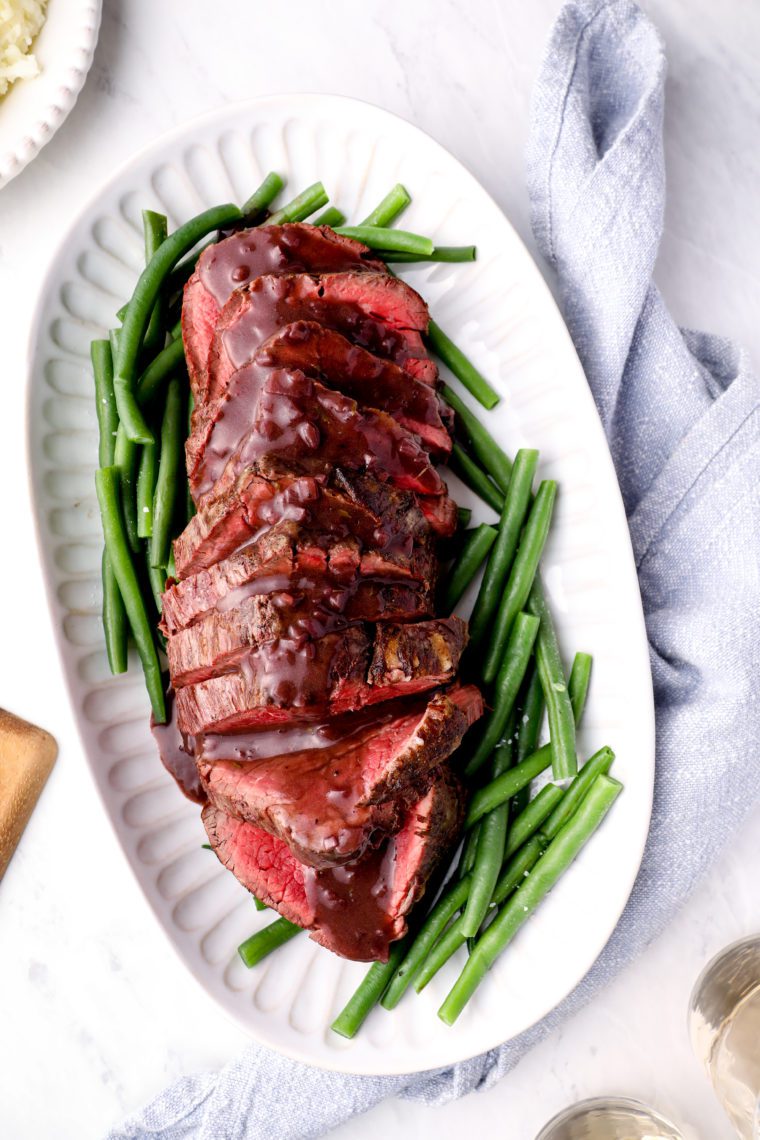
This beef tenderloin recipe is my #1 go-to recipe for holidays and special occasions. It never fails to impress, and my foolproof method ensures perfectly cooked beef every time, with no guesswork! The tenderloin is paired with a gorgeous French-style red wine reduction sauce, made by simmering a mixture of butter, shallots, red wine, and beef broth until the flavors deepen and intensify. Once reduced, a beurre manié (or flour and butter paste) is whisked in to thicken the sauce and give it a glossy sheen—yes, it’s fancy!
A great bonus is that the sauce can be prepared mostly in advance, so there’s very little fussing at the last minute. This beef tenderloin is truly the best of both worlds: simple to prepare yet incredibly delicious.
Table of Contents
“Voted best Christmas dinner ever! That is high praise. I served it with your thyme roasted carrots, shallot green beans and mashed potatoes. Thank you!”
Technique: Searing & Roasting Beef Tenderloin
Sear-roasting is an excellent method for cooking beef tenderloin. You begin by searing the tenderloin on the stovetop to create a beautifully crusty, brown exterior—this adds incredible flavor and texture to the lean cut. Next, transfer it to the oven and cook to your preferred doneness, using a leave-in meat thermometer with a remote monitor. These are readily available on Amazon or at kitchen stores and are a worthwhile investment for cooking pricey cuts like tenderloin. Plus, it’s great for other dishes too, like your Thanksgiving turkey.
What You’ll Need To Make Roast Beef Tenderloin With Red Wine Sauce
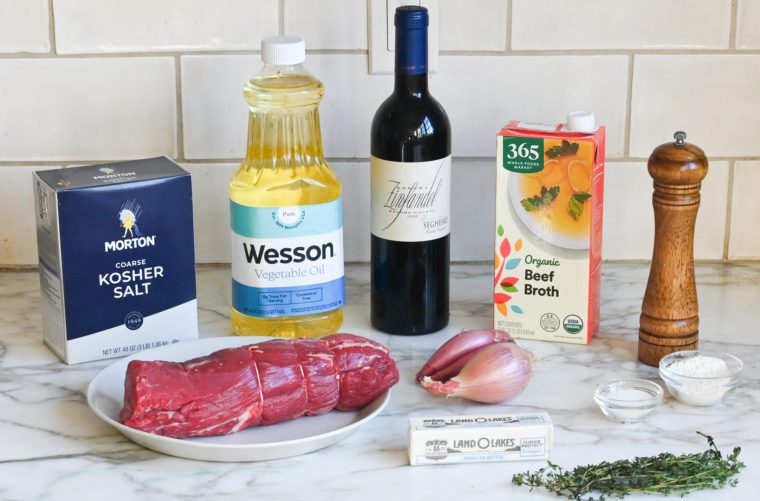
- Beef tenderloin: The most tender and expensive cut of beef available, beef tenderloin refers to the whole tenderloin before it is sliced into steaks. Once cut, those steaks are referred to as filet mignon (used in recipes like steak au poivre or pan-seared steaks). Beef tenderloin can be labeled and sold in different ways depending on the butcher or retailer. Common labels include “whole tenderloin,” “filet mignon,” “Chateaubriand,” or “tenderloin roast.”
- Butter: Provides richness and flavor. A portion is used for sautéing shallots, while the rest is combined with flour to create a beurre manié, which thickens the sauce.
- Shallots: Adds a sweet and mild onion flavor to the sauce.
- Red wine: Infuses the sauce with rich, fruity flavors and adds depth of color.
- Beef broth: Provides a savory base for the sauce; also used to deglaze the pan after roasting the beef.
- Thyme sprigs: Adds aromatic herbal notes to the sauce.
- All-purpose flour: Mixed with butter to create a beurre manié, a thickening agent for the sauce, giving it a smooth and velvety texture.
- Jump to the printable recipe for precise measurements
Step-by-Step Instructions
Step 1: Make the Sauce
Melt 5 tablespoons of the butter in a medium saucepan.
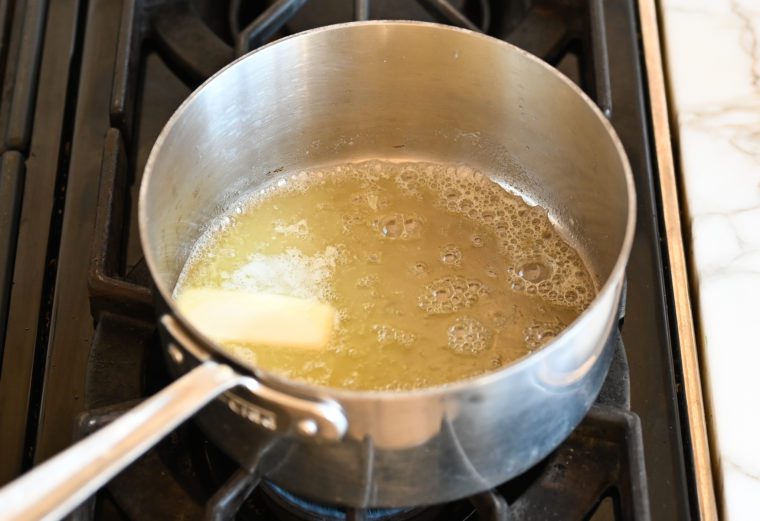
Add the shallots.
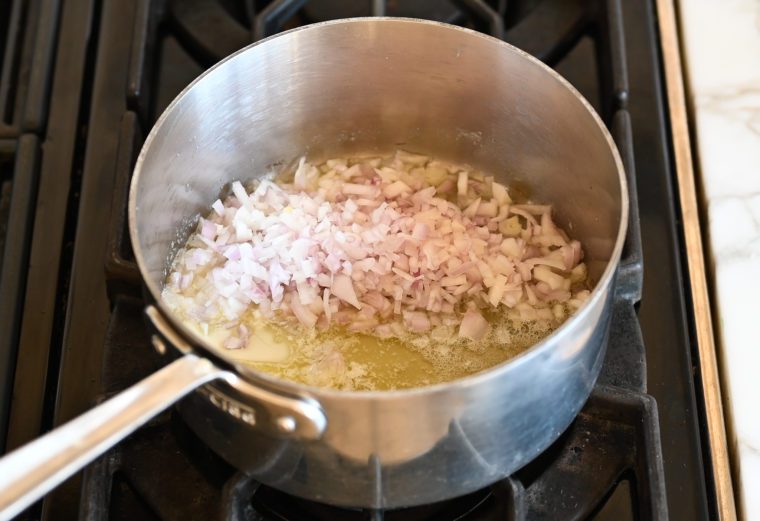
Cook over medium-low heat until soft and translucent, 7 to 8 minutes.
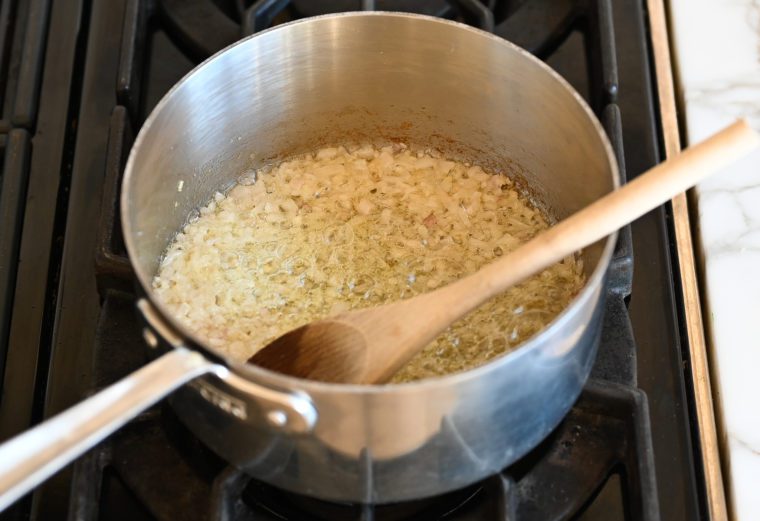
Add the wine, beef broth, thyme sprigs, salt, pepper and sugar, and bring to a boil.
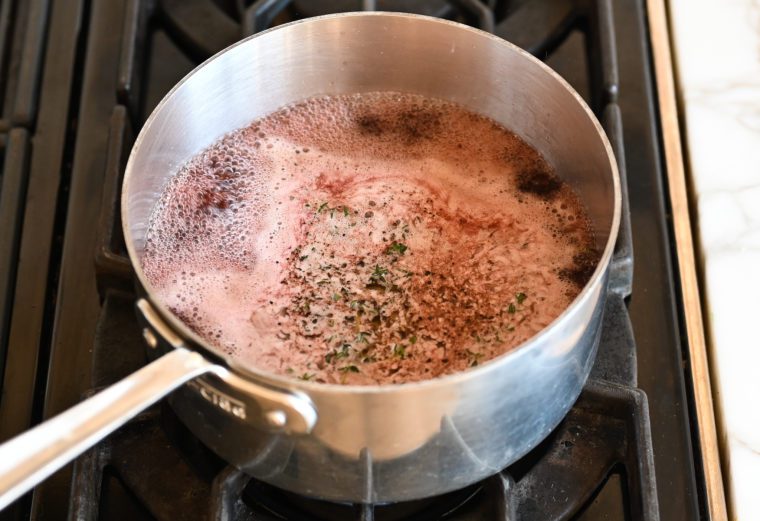
Cook over medium heat for about 30 minutes, or until the liquid is reduced by about half.
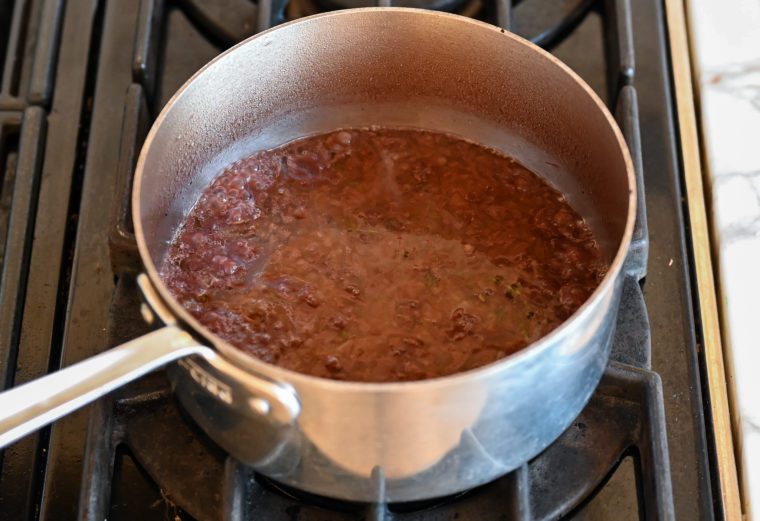
While the liquid is reducing, place the remaining 3 tablespoons of butter in a small bowl. Soften in the microwave (if necessary), then add the flour. Using a spoon, mix together into a paste. This is called a beurre manié, and it’s used to thicken sauces.
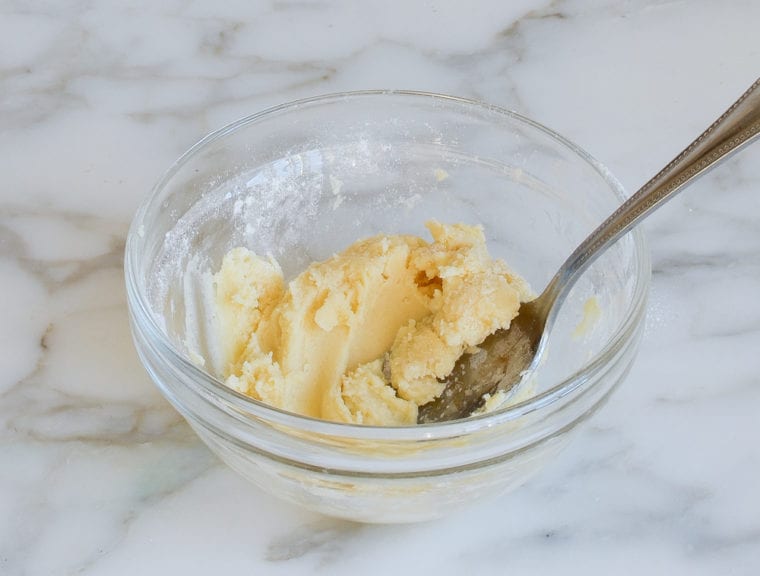
Once the wine mixture is reduced, reduce the heat to low and remove the thyme sprigs. Whisk the flour-butter mixture, a tablespoon at a time, into the simmering liquid, and simmer for a few minutes, until the sauce is thickened. The sauce can be made up to this point and refrigerated several days ahead of time.
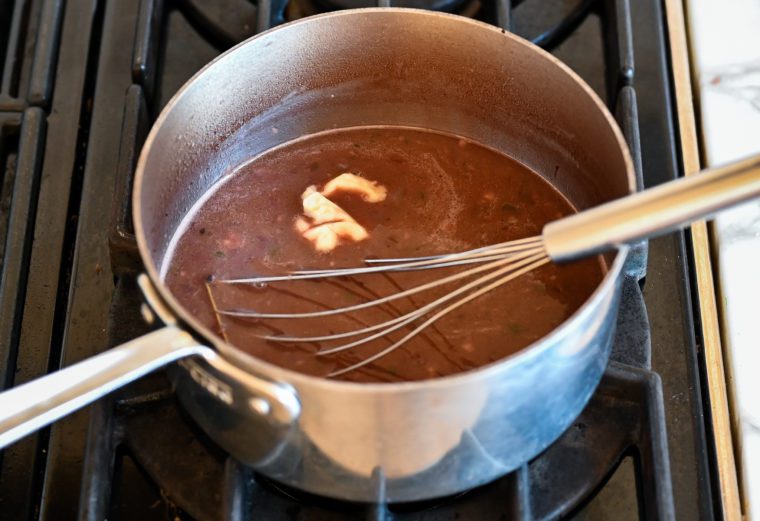
Step 2: Roast the Beef Tenderloin
Begin by seasoning the beef with kosher salt and freshly ground black pepper. Don’t be shy with the seasoning; it needs a lot.
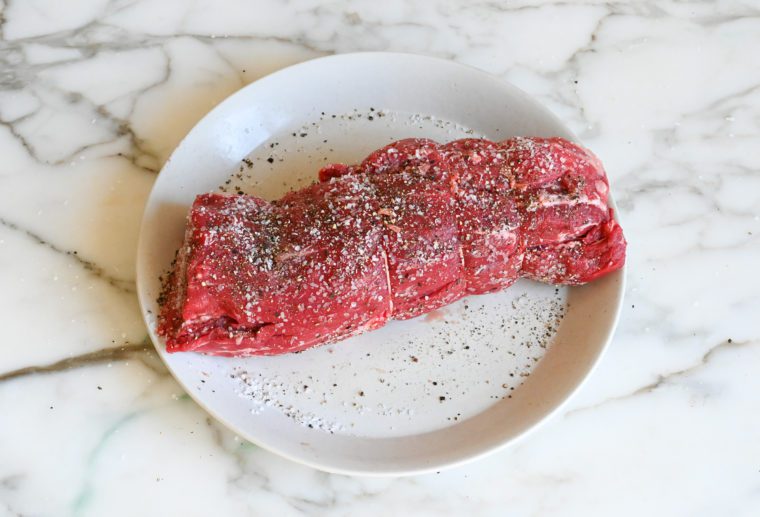
Heat the oil in an oven-proof skillet over medium-high heat until almost smoking. Cook, turning with tongs, until well browned with a nice crust on all but one side, about 10 minutes total.
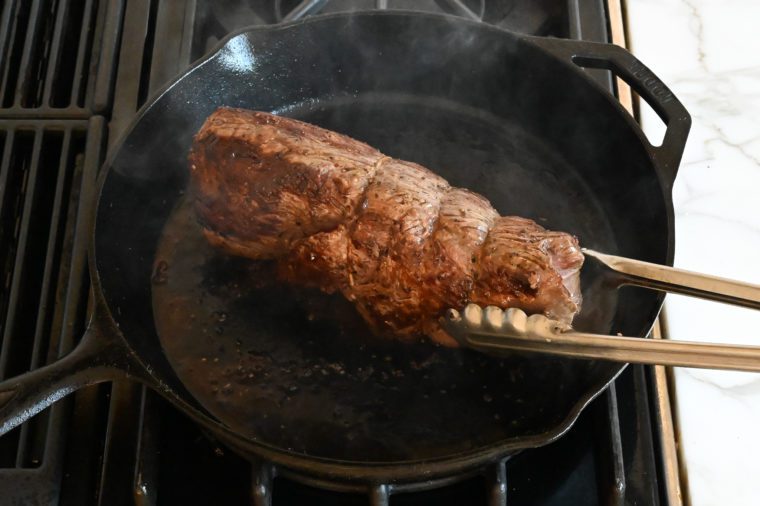
Turn the tenderloin so that the un-seared side is down and transfer the skillet directly to a 400°F oven.
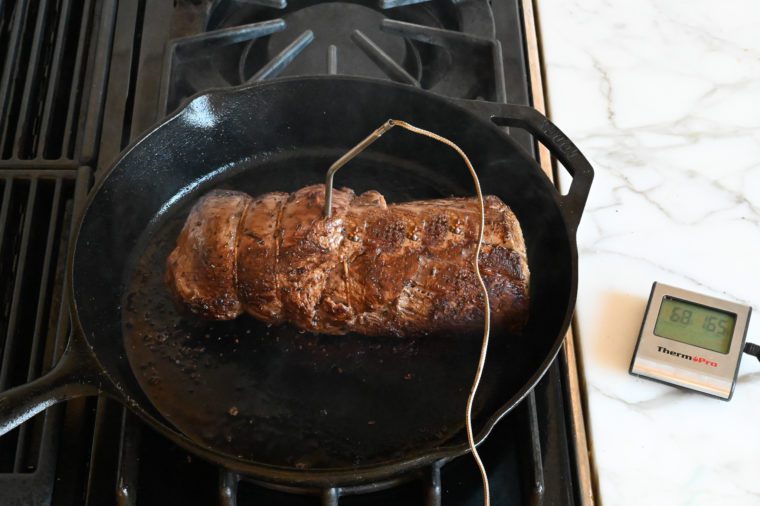
Roast until a thermometer inserted into the center of the meat registers 120ºF-125°F for medium-rare, 15 to 20 minutes, or until done to your liking. (Note that a perfect medium-rare roast will register around 130°F, but the internal temperature of the meat will continue to rise 5-10°F after it is removed from the oven, so it’s best to pull it out a little early to account for the carry-over cooking.) If you prefer your roast cooked to medium, pull it out of the oven at 130°F.
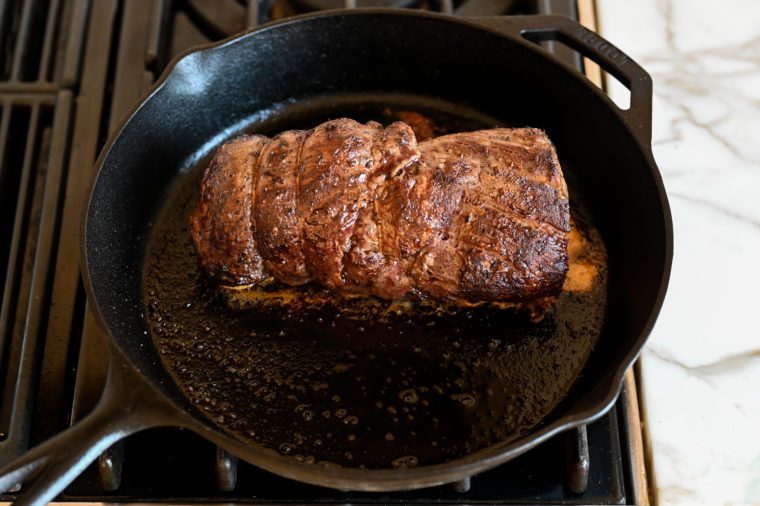
Step 3: Finish the Sauce & Carve the Tenderloin
Transfer the roast to a carving board (preferably with a well for collecting juices) and let it rest at room temperature, covered loosely with aluminum foil, for 10 to 15 minutes. This allows the juices to redistribute from the outside of the roast throughout the whole roast, making the tenderloin juicy. If you slice it too soon, the juices will pour out of it.
Meanwhile, pour off the fat from the roasting pan. Set the pan on the stovetop and add the beef broth. Bring the broth to a boil, using a wooden spoon to scrape the fond (brown bits) from the bottom of the pan.
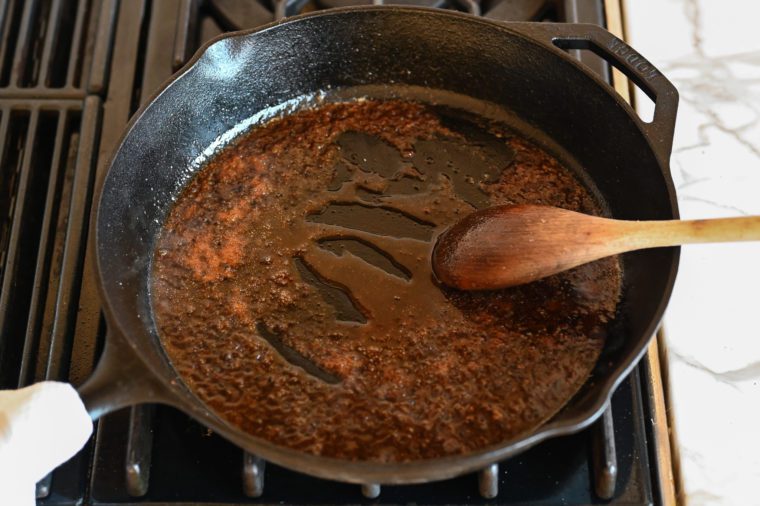
Add the flavorful broth to the red wine sauce, and bring the sauce to a simmer.
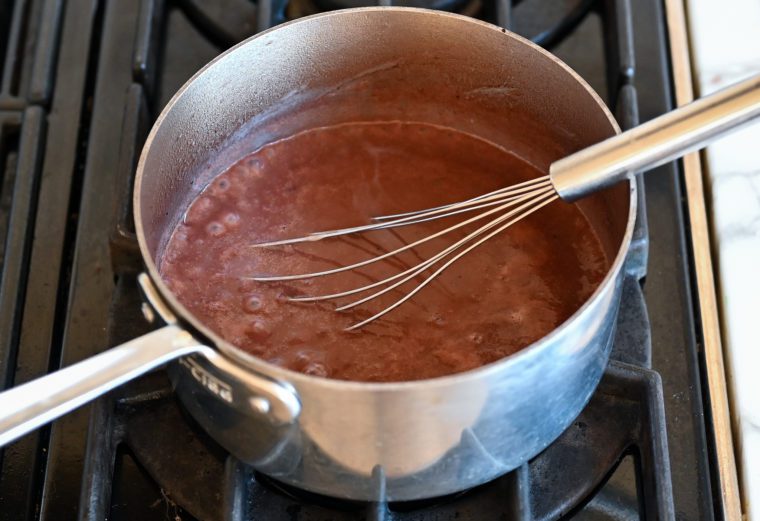
Carve the roast into 1/3-inch-thick slices.
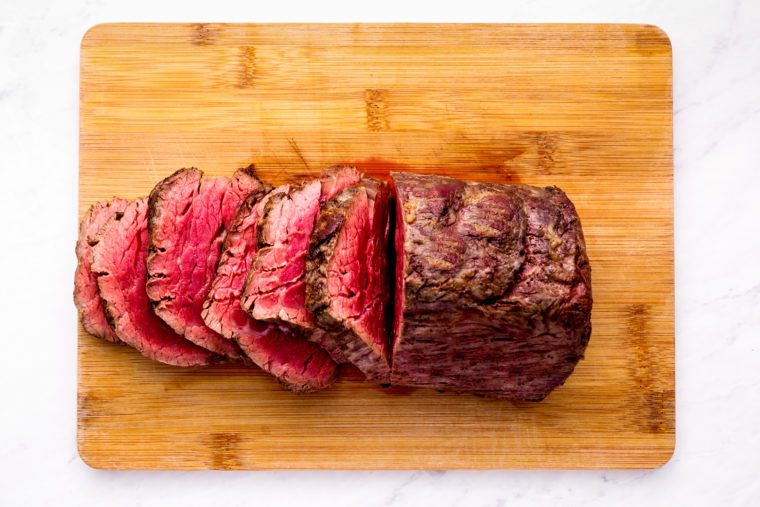
Serve the beef, passing the red wine sauce at the table.
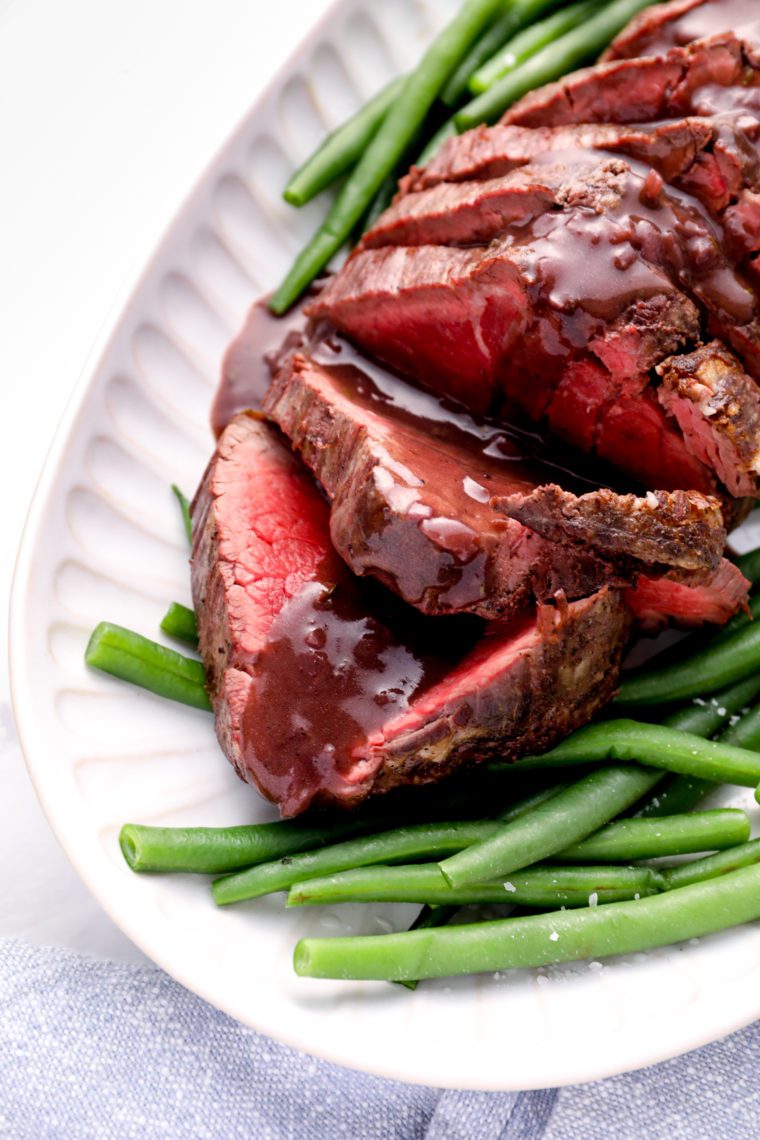
Frequently Asked Questions
Your tenderloin may have some butcher’s twine tied around one end of it; butchers often tie tenderloin up near the tapered end so that it is the same thickness all the way around. If yours comes that way, leave the string on until after it’s cooked. If it doesn’t, no worries—no need to do any tying.
When selecting a wine for the sauce, any red variety such as Merlot, Pinot Noir, Cabernet Sauvignon, Syrah, or Red Zinfandel will work well. It’s not necessary to overthink it or use anything too pricey; opt for a bottle that’s inexpensive yet still enjoyable to drink. Always avoid supermarket “cooking wines,” which contain salt and additives.
Unfortunately, I don’t recommend searing the beef in advance due to food safety concerns. Sear the beef just before cooking to be safe.
As a general guideline, plan for about 8 ounces (225 grams) of beef tenderloin per person for a generous serving. However, this can vary based on individual appetites and what other dishes you’re serving.
You May Also Like
Video Tutorial
Beef Tenderloin with Red Wine Sauce
Wow your guests with ease! My roasted beef tenderloin paired with a rich red wine sauce is simple, sophisticated, and foolproof.
Ingredients
For the Sauce
- 8 tablespoons unsalted butter, divided
- ¾ cup finely chopped shallots, from 2-3 large shallots
- 1¼ cups red wine
- 3 cups beef broth
- 6 fresh thyme sprigs
- ¼ teaspoon kosher salt
- ⅛ teaspoon ground black pepper
- 1 teaspoon sugar
- 2 tablespoons all-purpose flour
For the Beef
- 1 (2 to 3 lb) center-cut beef tenderloin roast
- Kosher salt (½ teaspoon per pound of beef)
- Freshly ground black pepper (¼ teaspoon per pound of beef)
- 2 tablespoons vegetable oil
- ¼ cup beef broth
Instructions
For the Sauce
- Melt 5 tablespoons of the butter in a medium saucepan. Add the shallots and cook over medium-low heat, stirring occasionally, until soft and translucent, 7 to 8 minutes. Add the wine, beef broth, thyme sprigs, salt, pepper and sugar, and bring to a boil. Cook over medium heat for about 30 minutes, or until the liquid is reduced by about half.
- While the liquid is reducing, place the remaining 3 tablespoons of butter in a small bowl and soften in the microwave, if necessary (it should be soft but not melted). Add the flour and, using a small spoon, mix into a smooth paste.
- Once the wine mixture is reduced, reduce the heat to low and remove the thyme sprigs. Whisk the flour-butter paste, a tablespoon at a time, into the simmering liquid, and simmer for a few minutes, until the sauce is thickened. Set aside. (The sauce can be made up to this point and refrigerated up to 3 days ahead of time.)
For the Tenderloin
- Let the beef stand at room temperature for 1 hour before roasting. Set an oven rack in the middle position and preheat the oven to 400°F.
- Season the beef all over with kosher salt and pepper. Heat the oil in an oven-proof skillet over medium-high heat until almost smoking. Cook, turning with tongs, until well browned on all but one side, about 10 minutes total. Turn the tenderloin so that the un-seared side is down, and transfer the skillet directly to the preheated oven. (If your pan isn't oven-proof, transfer the beef to a lightly oiled roasting pan.) Roast until a thermometer inserted into the center of the meat registers 120°F-125° for medium rare, about 15 minutes, or until done to your liking (115°F-120°F for rare, 130°F-135°F for medium). Keep in mind that these temperatures account for the fact that the temperature will continue to rise about 5 degrees while the meat rests.
- Transfer the meat to a carving board (preferably with a well for collecting juices) and let it rest, covered loosely with aluminum foil, for 10 to 15 minutes. Place a dishtowel or oven mitt over the handle of the roasting pan to remind yourself that it's hot.
- Meanwhile, carefully discard the fat from the roasting pan (remember that the handle is hot!). Set the pan on the stovetop and add the ¼ cup of broth. Bring the broth to a boil and, using a wooden spoon, scrape the fond, or brown bits, from the bottom of the pan. Add the flavorful broth to the red wine sauce, and then bring the sauce to a simmer.
- Carve the tenderloin into ½-inch-thick slices. Serve the beef, passing the red wine sauce at the table.
Pair with
Nutrition Information
Powered by ![]()
- Per serving (6 servings)
- Calories: 1,001
- Fat: 61 g
- Saturated fat: 26 g
- Carbohydrates: 9 g
- Sugar: 3 g
- Fiber: 1 g
- Protein: 49 g
- Sodium: 1093 mg
- Cholesterol: 233 mg
This website is written and produced for informational purposes only. I am not a certified nutritionist and the nutritional data on this site has not been evaluated or approved by a nutritionist or the Food and Drug Administration. Nutritional information is offered as a courtesy and should not be construed as a guarantee. The data is calculated through an online nutritional calculator, Edamam.com. Although I do my best to provide accurate nutritional information, these figures should be considered estimates only. Varying factors such as product types or brands purchased, natural fluctuations in fresh produce, and the way ingredients are processed change the effective nutritional information in any given recipe. Furthermore, different online calculators provide different results depending on their own nutrition fact sources and algorithms. To obtain the most accurate nutritional information in a given recipe, you should calculate the nutritional information with the actual ingredients used in your recipe, using your preferred nutrition calculator.

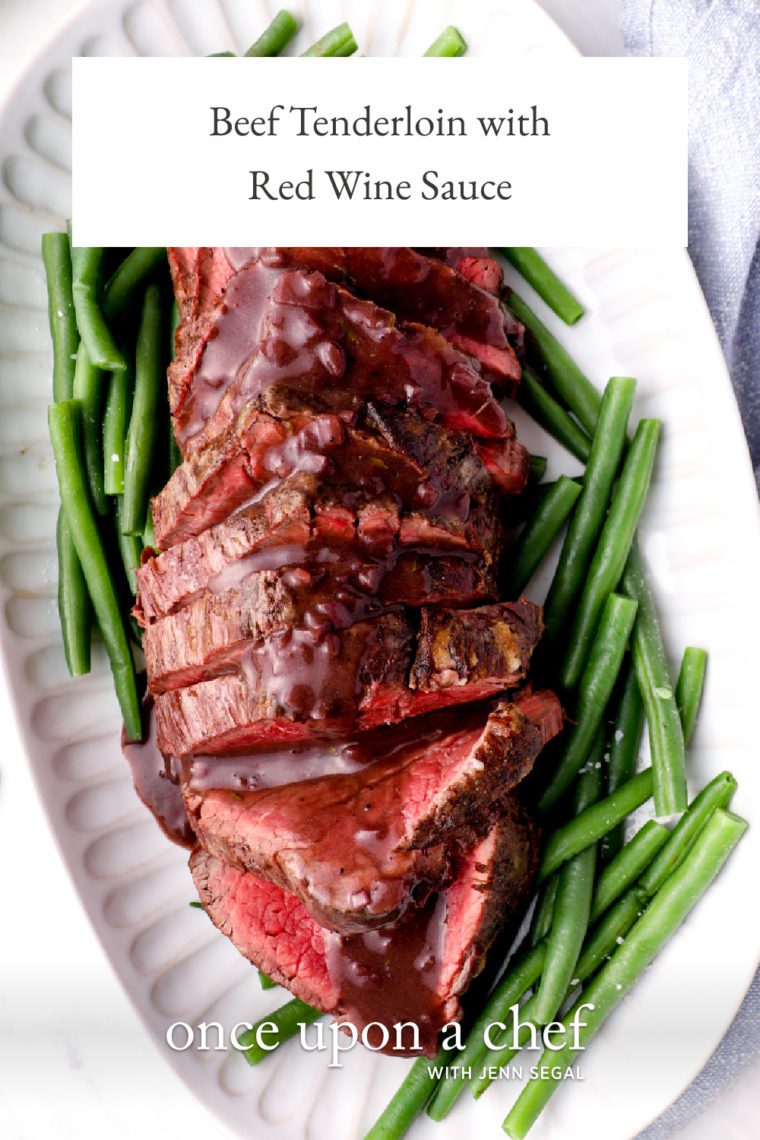
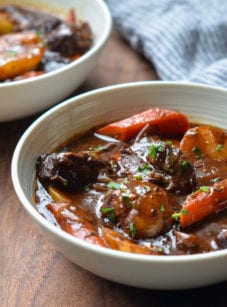
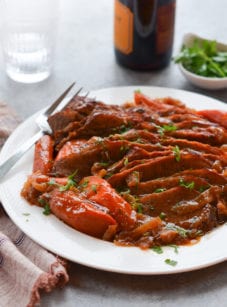

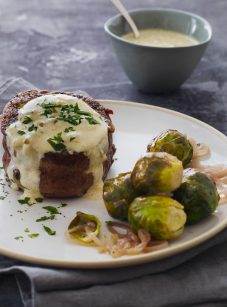
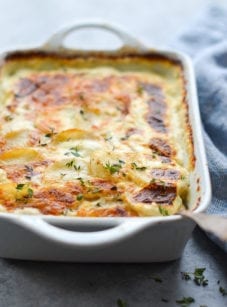
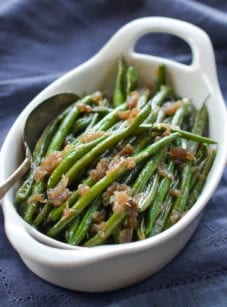

Prepared the Red Wine Sauce used on our Beef Wellington made on New Years Eve. Wow this was fantastic and new to the buerre manié world!
I made this for Christmas 2020; it was delicious. I made the red wine sauce the day before and added sliced mushrooms sauteed in butter to it. (However, I forgot to add the searing juices to the sauce, oh well.) It was very convenient to be able to make the sauce beforehand. The beef tenderloin that I bought at Costco was perfectly cooked to 125 degrees and then I let it rest for a bit. It was served medium rare leaning toward rare. I found that the recipe timing was very accurate. I think in the future I might cook it to 130 degrees and let it rest. I will make this again and probably again; it was so good.
I made this recipe for our Christmas dinner this year. After reading many of the reviews I felt pretty good about serving this. It did no disappoint. I bought a 6 pound USDA prime tenderloin from Costco and used home made beef broth. It was fantastic! Cooked to perfection and so moist and tender. The sauce really put it over the top. I was expecting a lot of leftovers for sandwiches but there was not that much. Everyone went back for a second piece. Served it with potatoes au gratin with some carmelized onions worked in. Fantastic. I will definitely go back to this recipe. Thanks.
Wow! Another great recipe. The sauce was straightforward to make, but had the flavor of a top French restaurant. It was a perfect Christmas dinner. Thanks Jenn
My daughter was unable to have a large extended family and friend wedding reception for 180. Instead, we opted for an intimate siblings and parents only wedding with a dinner outside under our gazebo. I couldn’t get a caterer to come to our home to cook so I enlisted a couple close friends who are great cooks in their own right and a couple of HS girls to serve. I did a ton of prep the day before including making the appetizers, the sauce and the mashed potatoes. My menu included your beef tenderloin, seared lemon scallops, garlic mashed potatoes and roasted asparagus. I doubled the sauce as I had 3 tenderloins for 16 people ( wanted leftovers you know). It was absolutely wonderful. So delicious, tender, and cooked to perfection. I opted to serve it again for Christmas dinner. I wanted to enjoy it minus the blur of a wedding day. Of course, I made 2 tenderloins knowing the big boys would want more the next day. I had enough to take the leftover sauce, add some sauteed fresh mushrooms and a bit of cream. After heating it all up, I threw in some leftover tenderloin cut into 1-inch chunks and reheated just barely. I served it over egg noodles for a very delicious beef burgundy. Still some left for sandwiches. So really, one 3 lb tenderloin feeds 8 easily. One last comment, I really like your precise measurements. Once one becomes familiar with particular seasonings, then it’s easier to just wing it. It is very helpful for a new recipe. Thank you so much.
Cooked this exactly like your recipe. It was fantastic! That red wine sauce is better than any sauce I have tried in the past. Server it with air fryer French fries, spinach with a white sauce and Caesar salad.
I made it for Christmas Eve dinner. Amazing! Elegant and super delicious. Everyone was really happy 🙂
I made this dish for Christmas dinner with the Scalloped potatoes. The meat was perfect and the red wine sauce was excellent as were the potatoes. Definitely will make again!!
Hi Jenn,
What cut of beef did you use for your recipe? Prime or Choice? We made this for Christmas dinner and used a prime cut, but had almost nothing in drippings to add to the sauce. Is prime too lean of a cut? Overall the dinner was delicious, and will definitely be making again, but I will make two separate batches of the sauce instead of doubling it the first time. I’m not sure it tasted or looked quite like your recipe.
Also any suggestions for keeping the meat and sauce hot while serving? It seemed to cool off so quickly. Thank you!
Hi Lynn, the prime cut explains your lack of drippings (because it’s so lean). This is the one cut of beef where a choice cut is preferable to prime. Regarding keeping the meat and sauce hot while you’re serving, you could keep them in covered dishes. I wouldn’t do anything like a warming tray as that will continue to cook the meat.
Thanks so much for the info. Choice it will be for next Christmas. A delicious recipe overall!!
Happy New Year!
Lynn B
Actually, prime cuts have more marbling, which means MORE fat. Choice cuts are more lean. Just for clarification.
This was the most tender and juicy tenderloin I have ever prepared thank you for sharing this will be a great company treat when we are allowed to all get together again
Hands down the best beef tenderloin recipe I’ve had the pleasure of using. It was easy to follow, easy to prepare, and the final gourmet result far exceeded the ease of making it. The red wine sauce was a huge success at our Christmas dinner, and paired perfectly with the potato gratin and roasted carrots. I prepared mine the day ahead and it reheated nicely. It was a bit thick but once I added the juices from the roasting pan it thinned out to a thinner and smoother consistency. I had a bit of sauce leftover and used it on a seared duck breast the next day and it was also heavenly! I will be using this recipe again and again and have already sent it to a few family members.